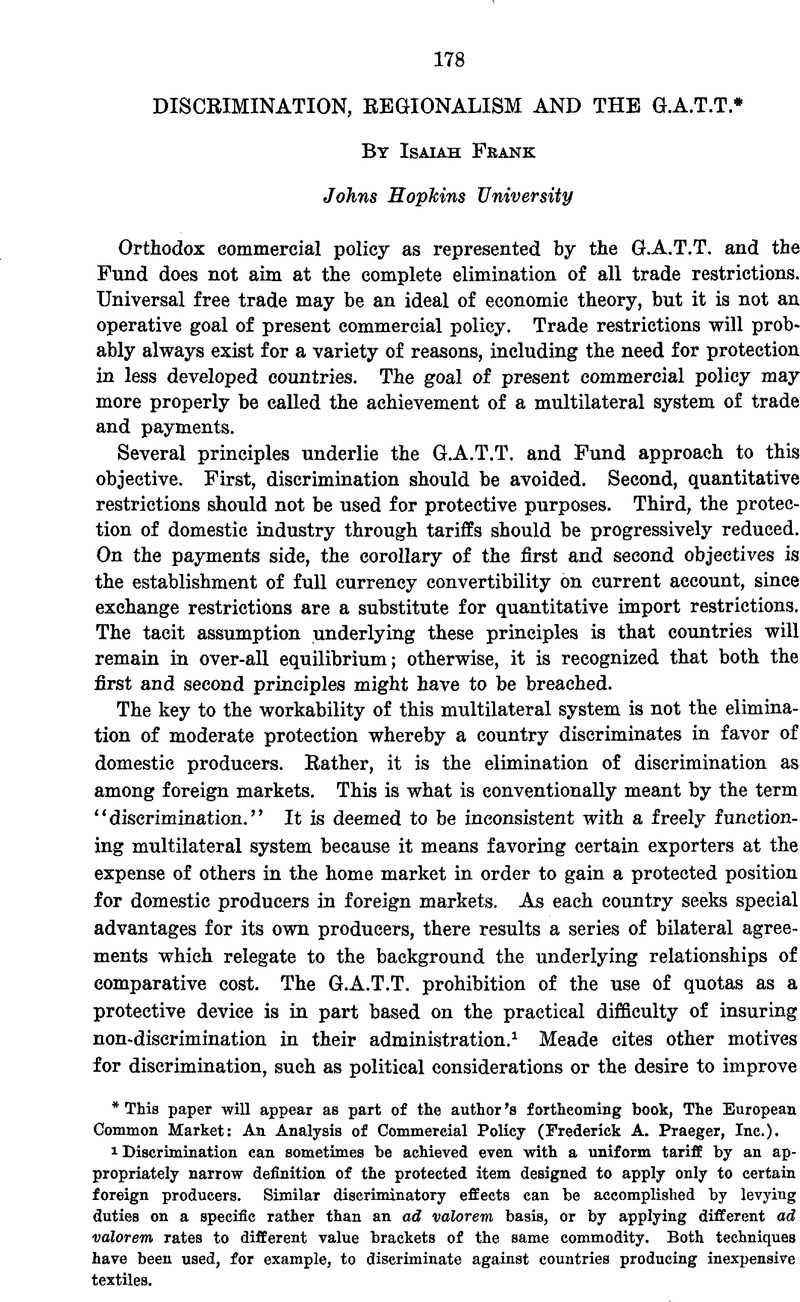Published online by Cambridge University Press: 27 February 2017

This paper will appear as part of the author's forthcoming book, The European Common Market: An Analysis of Commercial Policy (Frederick A. Praeger, Inc.).
1 Discrimination can sometimes be achieved even with a uniform tariff by an appropriately narrow definition of the protected item designed to apply only to certain foreign producers. Similar discriminatory effects can be accomplished by levying duties on a specific rather than an ad valorem basis, or by applying different ad valorem rates to different value brackets of the same commodity. Both techniques have been used, for example, to discriminate against countries producing inexpensive textiles.
2 J. E. Meade, The Theory of International Economic Policy, Vol. I: The Balance of Payments 383–385 (London: Oxford University Press, 1951).
3 G.A.T.T., Basic Instruments, Art. II.
4 Gottfried von Haberler, The Theory of International Trade 390 (London: William Hodge & Co., 1936).
5 The general exception in G.A.T.T. Art. XX for the protection of publie health and morals and for certain other specified purposes is also open to members of a customs union or free-trade area.
6 The precise meaning of this standard is open to even wider differences of interpretation than the one relating to the elimination of internal duties. This problem is considered in detail in the author's forthcoming book.
7 P . J. Verdoorn, “A Customs Union for Western Europe: Advantages and Feasibility, “ 6 World Politics 486 (July, 1954).
8 Clair Wilcox, A Charter for World Trade 71 (New York: Macmillan Co., 1949).
9 This point was stressed by the Canadian Prime Minister in commenting on the Common Market proposals in 1956. “ … A partial development that resulted only in the creation of a new system of intra-European tariff preferences would interfere with trade between Europe and other countries, including Canada, without achieving the positive results that are expected from a full implementing of the plan. ” 106 Foreign Trade No. 12 (Ottawa, December, 1956).
10 The G.A.T.T. has approved interim agreements for a customs union between the Union of South Africa and Southern Rhodesia, and for a free-trade area in the case of Nicaragua and El Salvador. In 1956 the contracting parties approved a proposed interim agreement looking toward the establishment of a free-trade area among Nicaragua and four other Central American countries not parties to the G.A.T.T., namely, El Salvador, Costa Eica, Guatemala and Honduras. Raymond F. Mikesell, “Quantitative Import Restrictions and United States Foreign Trade Policy,” in Foreign Trade Policy, a compendium of papers for the Subcommittee on Foreign Trade Policy of the Committee on Ways and Means 468 (Washington, 1957).
11 Wilcox, op. cit. 70–71.
12 Jacob Viner, The Customs Union Issue 49 (New York: Carnegie Endowment for International Peace, 1950).
13 Ibid. 50–51. See also Gottfried von Haberler, “Implications of the European Common Market and Free Trade Area Project for United States Foreign Economic Policy,” in Foreign Trade Policy, op. cit. 479.
14 The distinction drawn here does not apply with equal force as between a free-trade area and a preferential agreement. In the case of a free-trade area, a partner can seek to offset, at least to some extent, the balance-of-payments effects of domestic inflation through a unilateral increase of restrictions against outsiders. In a customs union external restrictions would formally be a matter of common interest and therefore a less readily accessible remedy.
15 Although not referring specifically to monetary and fiscal co-ordination, Haberler in 1936 called attention to the problem in the following terms: “When one reflects how difficult it often is, even in a unified State, to fix upon a tariff, owing to the conflict of wishes and opposition of interests of the various parties concerned, and when one remembers what a painful process it was to get an agreement between the two halves of the old Austria-Hungary, despite the bonds of a common monarch and a common army, one is forced to the conclusion that apart from exceptional cases, these problems are practically insoluble. Moreover, an agreement must be reached as to the division of customs revenue, as to questions of taxation, and as to measures of customs administration. Indeed, modern history presents us with one sole example of a successful Customs Union: The German Customs Union leading to the German Eeich.” Theory of International Trade, op. cit. 391.
Viner in 1950 pointed out that, because of the growth in government intervention and other factors, there was no longer any automatic international equilibrating mechanism. “Two neighboring countries contemplating complete customs union today must therefore contemplate also the necessity of harmonizing their general patterns of economic controls, which would involve a much more complete degree of economic unification than would a representative nineteenth-century customs union.” Op. cit. 136.
16 This problem came to a head at the G.A.T.T. tariff negotiations at Torquay in 1950.
17 Since 1948 the power of the President to reduce tariffs has been substantially reduced as a consequence of the enactment of the “peril point” amendment. The latter limits the extent to which he may use whatever quantitative authority the Congress confers. The “peril point” provision requires the Tariff Commission to survey all commodities on which the President proposes to negotiate agreements and to specify rates of duty below which, in the Commission's judgment, tariffs could not be lowered without injuring the domestic industry concerned. Although the President can disregard the findings of the Tariff Commission and reduce tariffs below the peril points, there is an overwhelming presumption that he will not do so. (In such cases, he is required to explain his actions in writing to the Congress.)